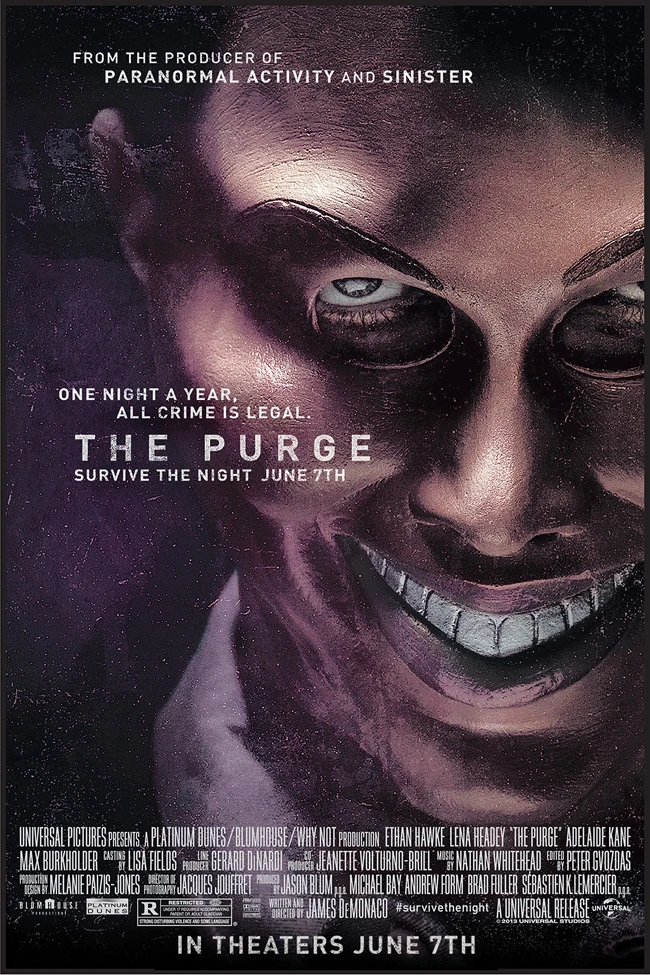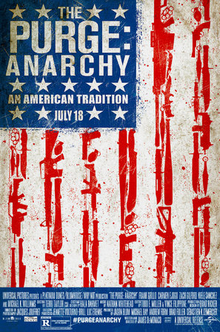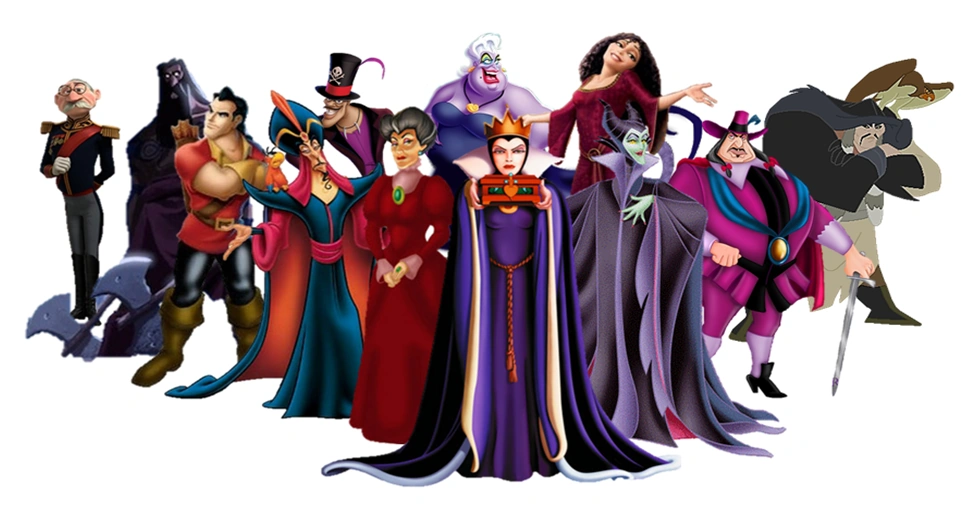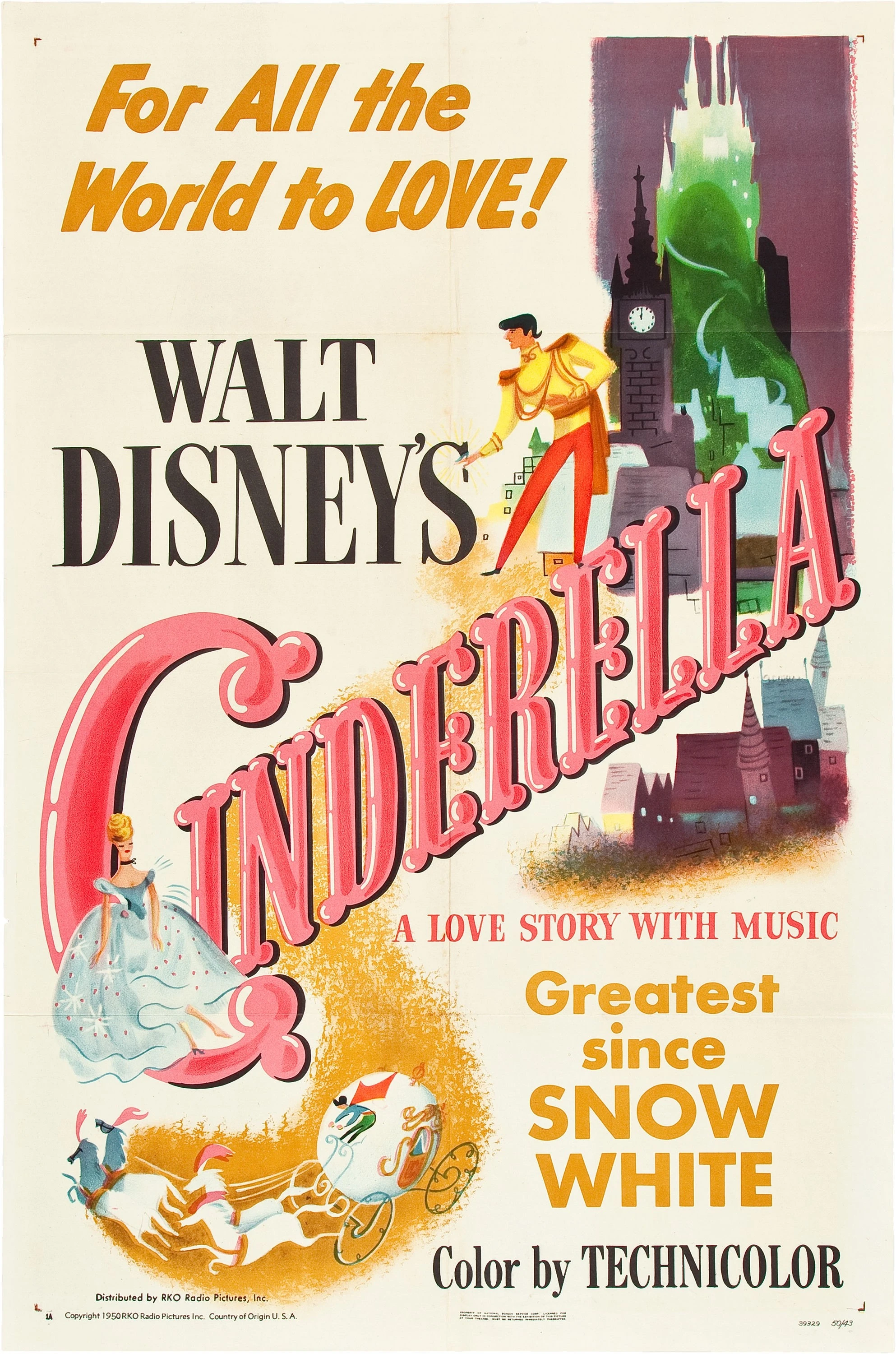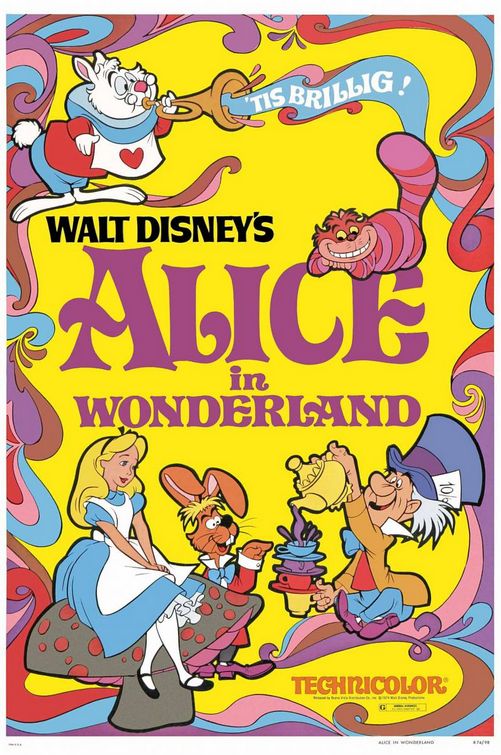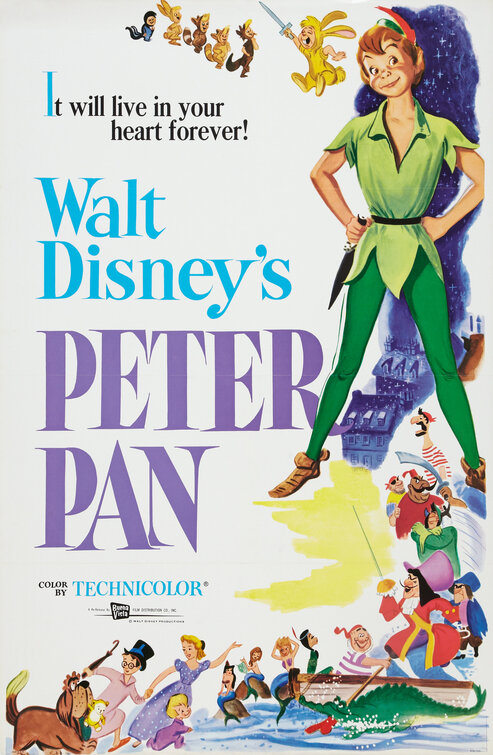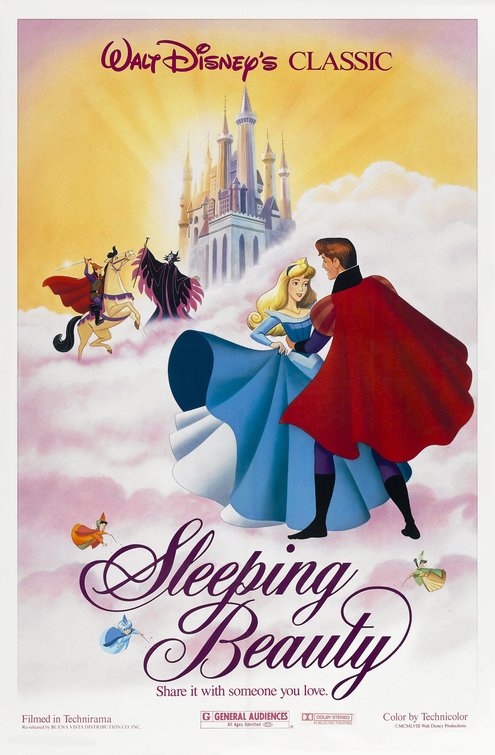
This Halloween, I decided to go all out for the annual
horror-themed post for this site, especially considering that I… sort of forgot
to do one last year. For the record, I was planning to do a retrospective on
the Halloween franchise because I
figured that it was time to tackle a classic horror franchise. But I ultimately
didn’t have the time, nor the means for that matter, to go through all the
films so I ended up scrapping that post. Seriously, the review that I did for
the new Goosebumps film last year was
basically the only horror film review that I did during the month of October. So,
this year, I decided to do not one but two separate horror-themed posts to
compensate for the lack of one last year. Just a few days ago, I published the
first of these posts, which was a retrospective on the Purge films, even though they’re not exactly horror films. With
that in mind, for the main event, I decided to go back to one of the most
iconic periods in the history of the horror genre; the era of Universal’s
Monsters. Spanning over three decades beginning in the early 20’s and
culminating in the late 50’s, Universal at that time was best known for their
numerous monster films centering around various horror icons like Dracula,
Frankenstein, and the Wolf Man. Often starring the likes of Bela Lugosi
(‘Dracula’), Boris Karloff (‘Frankenstein’s monster’), and Lon Chaney Jr. (‘The
Wolf Man’), these films were huge hits for the studio and many of them still
stand as classics of both film and the horror genre.
They’re so famous that Universal is now attempting to do a
modern revival of the Monsters franchise by way of a Cinematic Universe, which
started with 2014’s Dracula Untold. However,
from what I hear, because that film did rather poorly with critics and
audiences, it seems as if that one is being excised from the franchise in favor
of having the upcoming reboot of The
Mummy start things off instead. Will this new monster series work for
Universal? For now, only time will tell but today we’ll be looking back at
their original monster films. Now for the record, I’m not going to be covering
every single ‘monster’ film that Universal made during this time because
otherwise I’d be here all day. Instead, I’m primarily going to focus on one
franchise; the Frankenstein franchise.
The reason why I picked this one to base the whole post around is because it’s
easily the biggest of Universal’s monster franchises with eight films in total.
However, some of the later films in the franchise were cross-overs that
featured other classic Universal monsters. So, with that said, I’ll also be
looking at the ‘first films’ that these other characters were in as well as a
few extra films based around characters that didn’t appear in the Frankenstein films but are still notable
members of Universal’s monster lineup. So, without further ado, grab your
pitchforks and your silver bullets and join me as I look back upon many of the
classic films that starred the Universal Monsters.
DRACULA (1931)
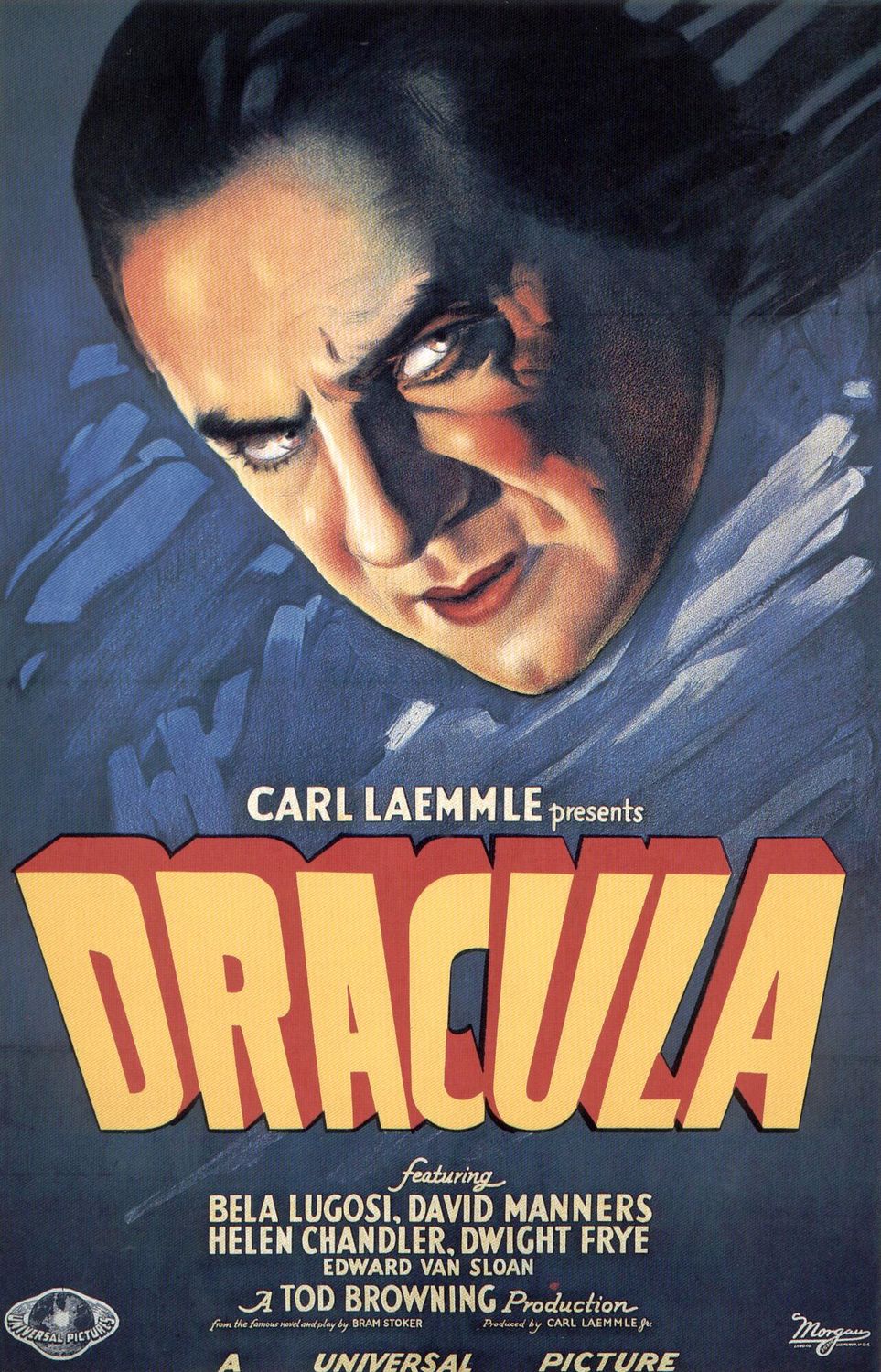
To start things off, we have the 1931 English-language
version of Dracula, based on both
Bram Stoker’s 1897 gothic horror novel of the same name and the 1924 stage play
by Hamilton Deane and John L. Balderston. Bela Lugosi stars in the title role
and is fantastic. He has great magnetism and the result is a truly hypnotic
performance, part of which comes from the fact that a lot of it is based around
his gaze. Whenever the film focuses in on him staring at somebody, his eyes are
always lit more than the rest of his face. As some have pointed out, it’s sort
of reminiscent of old silent films. But whatever way you put it, Lugosi is the
biggest selling point of the film. Admittedly this is a case of a film in which
the actions of Dracula are primarily implied rather than being shown on-screen.
But while some might interpret that as a case where ‘nothing happens’, the film
makes up for this by establishing a great sense of atmosphere. From the foggy
locales of Transylvania to the old, decrepit homes of Dracula, both in
Transylvania and London, to the fact that there’s no background score results
in a very atmospheric ‘chiller’. Now there actually was another adaptation of Dracula that was also made by Universal
around the same time. This version was a Spanish-language film that was shot at
night on the same sets that the English version used during the day. Many consider
the Spanish version to be the better of the two films from an artistic
perspective. However, due to me not wanting to overstuff this post more than it
kind of already is, I decided not to watch/review it for this retrospective.
Still, I’d argue that the English version of Dracula is still a pretty iconic entry in the horror genre, if
mostly just due to Bela Lugosi’s excellent performance in the title role.
Rating: 4/5
THE MUMMY (1932)
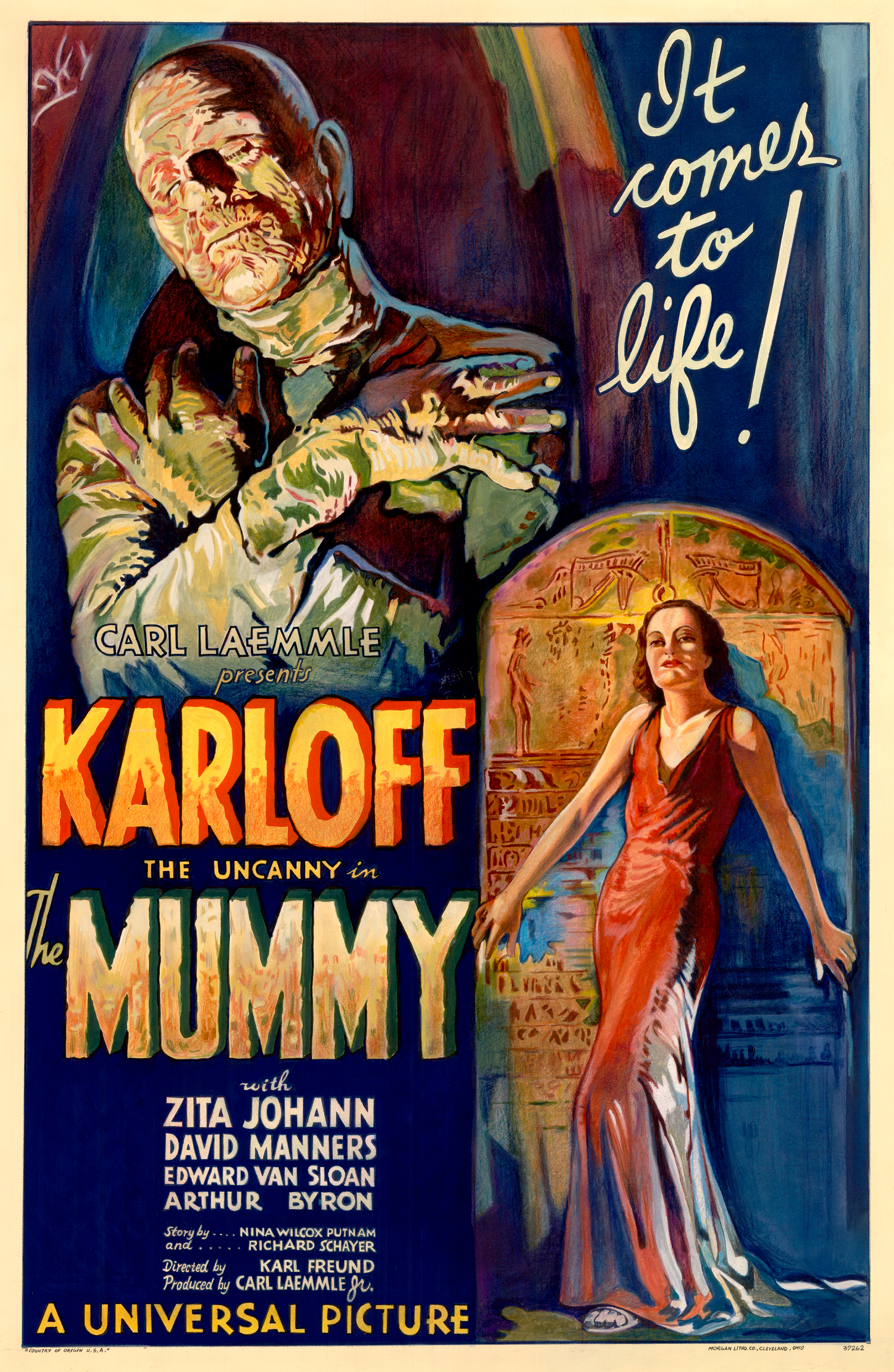
When it comes to The
Mummy and Universal Studios, nowadays most people are more familiar with
the trilogy of action films starring Brendan Fraser that ran from 1999 to 2008.
And from the looks of it, the new adaptation of The Mummy that is set to come out next year starring Tom Cruise
will also primarily be an action film. However, when it comes to the first
Universal Mummy film all the way back
in 1932, it’s more in line with the studio’s horror films of the time. Like Dracula, this is one of those films
that’s more dialogue heavy than it is about monster action though this time
admittedly it’s more of an issue. However, also like with Dracula (in fact this has quite a lot in common with that film when
you start to think about it), the key selling point of the film is its lead
star. Boris Karloff took on the second major monster role of his career as the
Egyptian priest Imhotep, who is revived by members of an archaeological expedition
in 1921, masquerades as an Egyptian named Ardath Bay a decade later, and
attempts to resurrect his lover, princess Ankh-es-en-amon. Obviously, Karloff
would become known more for his role as Frankenstein but he does do a great job
in the role of Imhotep. Like Lugosi as Dracula, there’s a hypnotic magnetism to
his performance and the image of his wrinkled face staring directly into the
camera is quite haunting. As I noted before, this one’s a rather slow burn but
I will say that the ending is quite a memorable one and does sort of make up
for some of the film’s duller moments beforehand. It’s quite interesting to
watch this film after seeing the 1999 Mummy
film multiple times over the years and seeing some of the references that the
newer film made despite being a totally different kind of film. But as for the
original Mummy, I can’t say that this
is one of the best Universal Monster films but it’s still worth checking out
for those wanting to see an old-school monster flick.
Rating: 3/5
THE INVISIBLE MAN (1933)

Two years after directing the original Frankenstein, director James Whale took on a different ‘monster’
story with The Invisible Man. It is based
on the 1897 novel of the same name by H.G. Wells about a scientist who ends up
turning invisible following a series of tests involving an obscure drug, which
end up turning him insane. And overall I must say that this is one of my
favorite entries in Universal’s line of monster films. Because the main
character Jack Griffin spends most of the film invisible, there’s a lot of
special effects work in this film and it is quite impressive for the time. Now
I’ll admit that from a modern perspective, this film kind of comes off more as
a ‘comedy’ than it does a ‘horror’ film, which I say only because some parts of
it are quite over the top. And yet… that ends up being the reason why this film
is so damn fun to watch. A lot of it is also thanks to Claude Rains’ terrific
and highly enthusiastic performance in the title role. His turn as Jack Griffin
constantly blurs the line between lunacy and charisma. Case in point, the scene
where he chases after a woman wearing only a pair of slacks that he took from a
police officer and chanting “Here we go gathering nuts in May, nuts in May,
nuts in May, here we go gathering nuts in May on a cold and frosty morning!”
Thanks to scenes like that as well as the terrific special effects and
outstanding performance by Claude Rains, the original Invisible Man stands as one of the most highly entertaining of
Universal’s monster films. Maybe it has something to do with the fact that
unlike some of these other films, it does keep its focus on the title character
throughout instead of focusing more on the side characters. Either way, the
film’s great.
Rating: 4.5/5
THE WOLF MAN (1941)
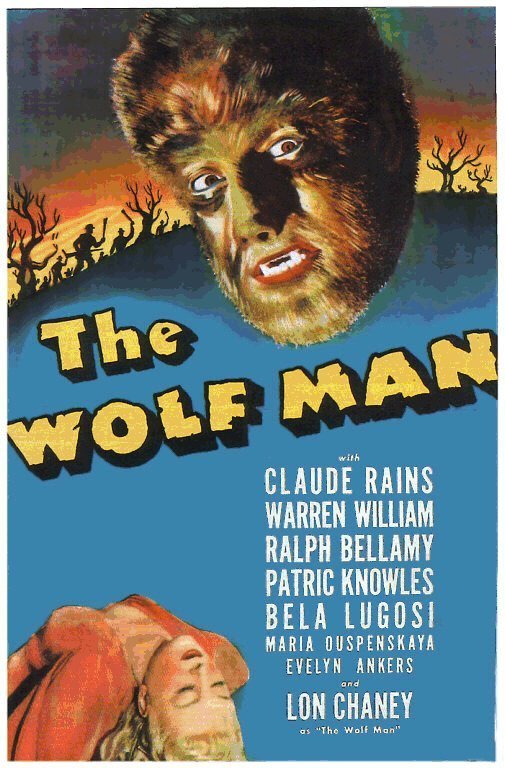
Some of the earliest installments of the Universal Monsters
series starred Lon Chaney, who was also known as ‘The Man of a Thousand Faces’
due to his skills in makeup design. This included films like Universal’s 1923
adaptation of The Hunchback of Notre Dame
and 1925’s pre-musical era The
Phantom of the Opera. His son, Lon Chaney Jr., soon continued his father’s
legacy by taking on a major makeup-heavy role of his own in The Wolf Man. This 1941 film is a pretty
star-studded film as it stars not only Lon Chaney Jr. in the role of Larry
Talbot, a man who becomes a werewolf after he’s bitten by another
man-turned-werewolf, but two other major stars of Universal Monster films. Claude
Rains (‘The Invisible Man’) plays Larry’s father Sir John while Bela Lugosi
(‘Dracula’) plays a gypsy named Bela who is the man who turned into a werewolf
and bit Larry. Like Dracula and The Mummy, this is another one of those
‘slow burn’ horror films but ultimately I feel that this film is the best of
the three when it comes to pacing. The build-up to the first scene of Larry in
his ‘wolf’ form is quite nice and this film benefits from some strong
atmosphere, especially in scenes set at night in foggy forests. Lon Chaney Jr.
does an excellent job in the title role, making Larry a sympathetic protagonist
amidst the ‘curse’ that befalls him. The makeup effects for his ‘wolf form’ are
excellent but it’s also neat how, prior to the first transformation but after
he got bitten by Bela, the film puts his psyche into question and how the curse
of the werewolf is starting to affect him. All in all, this is another one of
Universal’s best monster films thanks to a solid cast and great atmosphere.
Rating: 4.5/5
AND NOW, THE MAIN EVENT… THE
FRANKENSTEIN FRANCHISE
FRANKENSTEIN (1931)

In 1931, just 9 months after the release of Universal’s
other big monster film of the year, Dracula,
director James Whale brought a different famous horror novel to life on the
big-screen with Frankenstein, based
on the 1818 novel of the same name by Mary Shelley. It’s the story about a
scientist named Henry Frankenstein (he’s named Victor in the novel but that
name was given to the character’s best friend in the film, who ironically was
named Henry in the novel) as he builds a body out of the remains of the dead
and brings it to life with electricity. However, the monster soon proves to be
a problem as it begins to terrorize the town, all because his hunchback
assistant Fritz (Dwight Frye, who was fantastic as Renfield in Dracula) brought him an ‘abnormal’ brain.
Colin Clive stars in the lead role of Henry Frankenstein and does an excellent
job as he makes the character a sympathetic protagonist that is doing something
crazy while also staying fully committed to the part. As for his monster, Boris
Karloff stars in what is easily the definitive role of his career. He too is
excellent in what is a very physical performance with no dialogue. The build-up
to the monster’s first on-screen appearance is solid and like many of these
Universal Monster films, the film establishes a solid atmosphere throughout. It
all builds up to a climactic finale set atop a burning windmill. In short,
while the film is obviously dated by today’s standards, it’s still a solid
old-school chiller complete with great lead performances, solid set design, and
a well-handled atmosphere.
Rating: 4/5
BRIDE OF FRANKENSTEIN (1935)
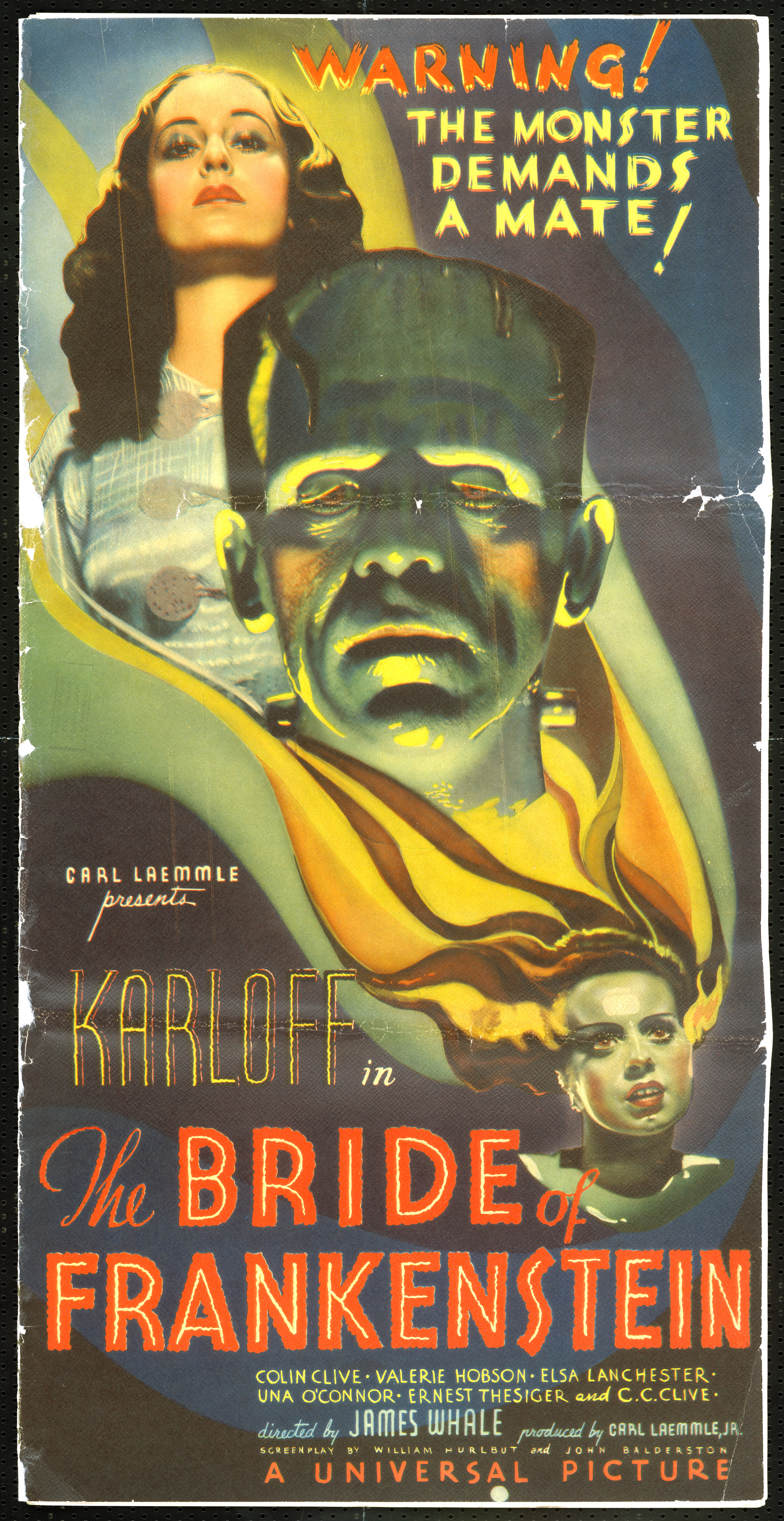
Although initially hesitant to do it at first, James Whale
returned to direct a sequel to the original Frankenstein
in 1935 with The Bride of
Frankenstein, continuing the story of Dr. Henry Frankenstein and his
monstrous creation as the former is confronted by a mad scientist named Dr.
Pretorius, who happens to be Frankenstein’s former mentor, who coerces
Frankenstein into creating ‘a mate’ for the monster. Colin Clive returns as
Frankenstein and is excellent once again, as it’s made clear that Frankenstein
has changed since the whole incident with the monster. Speaking of the monster,
Boris Karloff is also great once again and the film sees the monster continuing
to develop aka ‘become more human’, namely the fact that he gains the ability
to talk. But a major scene-stealer is Ernest Thesiger in the role of Pretorius,
a completely mad but entertainingly eccentric scientist. While the continuity
between films is a little off in some places (e.g. the recasting of
Frankenstein’s wife Elizabeth from Mae Clarke to Valerie Hobson), this very
much feels like a sequel that ups the scale in every way, from the set design,
which is just as great as it was in the previous film, to the visual effects,
which are quite impressive for the time (e.g. Pretorius’ ‘creations’ of
miniature people). But what about the title character, ‘the Bride’, played by
Elsa Lanchester who also plays Mary Shelley, the real-life author of Frankenstein, in a prologue intended to
bridge the two films? Well, believe it or not, Lanchester only appears as the
Bride in the final five minutes of the film. But in her brief screen-time, she
did manage to turn the Bride into another horror icon. In short, The Bride of Frankenstein is an excellent
sequel that many even consider to be better than the original. Do I concur with
that notion? I think I do because this is a case of a sequel that upped the
ante in every possible way to great results.
Rating: 4.5/5
SON OF FRANKENSTEIN (1939)

After the success of a double-feature re-release of Dracula and Frankenstein in 1938, Universal decided to continue making monster
films, with Son of Frankenstein kick-starting
this new era of revitalization. However, being the third installment of the
series and without the direction of James Whale or featuring the character of
Dr. Frankenstein (Colin Clive passed away in 1937, for the record), it seems as
if this might be an inferior follow-up. However, it turns out to be a solid
sequel that’s somewhat on par with its two predecessors. The biggest strength
of the film is its lead trio of characters. Basil Rathbone of Sherlock Holmes fame stars as Dr.
Frankenstein’s son Wolf. He proves to be very likable but also engaging in his
efforts to redeem his family’s name following the incidents involving his
father’s monster. Bela Lugosi takes on another Universal Monster film role as
the mysterious man named Ygor who uses the monster to enact revenge upon the
townspeople who had him hanged years earlier. Simply put, Lugosi’s performance
is on par with his turn as Dracula. Finally, there’s Lionel Atwill (who would
go on to star in the next four Frankenstein
films as well) as Inspector Krogh, who keeps an eye on the Frankenstein
family, protecting them from angry villagers, but also has a bit of distrustful
feelings towards them because of an incident in his childhood when the monster
ripped off his arm. The moral conflicts that emerge between these three are
easily one of the best parts of the entire film.
But what about the monster, once again played by Boris
Karloff in what would be his last major turn in the role in a Universal Monster
film? Well, unfortunately the monster is relegated to a side character in this
film and it also reverts to not having him speak after he learned to in Bride. Still, Karloff does a good job in
the role. Really, the only major issue with this film is its length. Whereas all
the other films in this retrospective are around 65-70 minutes each, this was
the longest of the franchise at one hour and forty minutes. Thus, the pacing is
a lot more leisurely whereas the other films are much brisker due to their
shorter runtime. It’s not entirely a ‘bad thing’, as it does allow for more
character development in regards to the main characters, but it could’ve used a
few trims here and there. Plus, despite being credited as a sequel to the
previous two films, eagle-eyed viewers are surely going to note a whole bunch
of continuity errors here and there (and trust me, it only gets worse from
here). But overall, Son of Frankenstein is
a solid sequel thanks to the strong performances from its three lead actors
(plus Karloff as the monster, of course), excellent set design that showcases
the bigger budget that the film had compared to its predecessors and kind of
reminds you of a Tim Burton film, and arguably some of the best character
development of any Universal monster film.
Rating: 4/5
THE GHOST OF FRANKENSTEIN (1942)
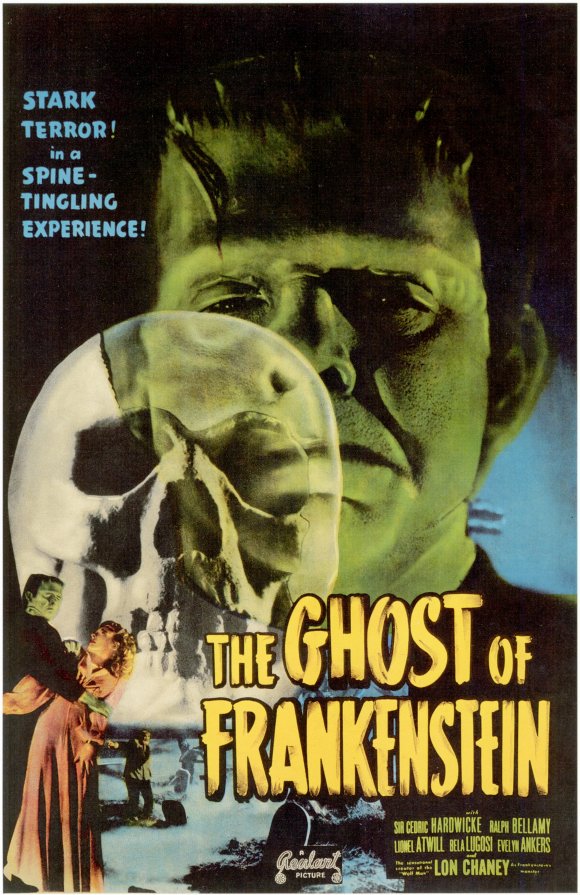
Just like how Bride of
Frankenstein is the primary sequel to the original Frankenstein, The Ghost of
Frankenstein is the primary sequel to Son
of Frankenstein. Again, there are some continuity errors here and there
(e.g. the monster apparently gets stronger when struck by lightning, even
though in the last film it was lightning that sent him into a coma for the
first third of it) but overall it does continue the story that has been
building through these first four films. It even brings back the character of
Dr. Henry Frankenstein, who appears as a ghost to his son, and the film’s main
character, Ludwig. Albeit here he is not played by Colin Clive but instead Cedric
Hardwicke who also plays Ludwig. Bela Lugosi returns as Ygor and is great once
again. The plot even ends up resulting in his brain being put into the monster’s,
which is a freaky moment once the monster starts speaking in his voice. Lon
Chaney Jr. steps into the role of the monster, replacing Boris Karloff. Unfortunately,
Chaney doesn’t get much to work with here to the point where the monster
doesn’t even say a word until Ygor’s brain is put into him. So, in short, The Ghost of Frankenstein is easily the
weakest of the original four Frankenstein
films. There are some things about it that do make it worth checking out.
These include Bela Lugosi as Ygor, who’s still a great bad guy, a solid
performance by Cedric Hardwicke in the lead role, and the usual solid set
design of these films. But overall, it’s just ‘ok’ at best.
Rating: 3/5
FRANKENSTEIN MEETS THE WOLF MAN (1943)

Now Universal was starting to release their big monster
films on an annual basis and in 1943, they gave us the first big ‘monster crossover’
event film in the form of Frankenstein
Meets the Wolf Man. Basically, it’s primarily a sequel to The Wolf Man as Larry Talbot is brought
back to life following his death in that film and now seeks another way to end
his eternal life. In doing so, he comes across Frankenstein’s monster, who in
this film is played by none other than Bela Lugosi. Interestingly, Lugosi was
originally considered to play the part all the way back in 1931 in the original
Frankenstein but he turned it down,
presumably due to him claiming that there wasn’t much to the role. But he would
get his chance more than a decade later and overall he does a decent enough job
in the role. Like Karloff in Son,
he’s limited by the fact that the monster doesn’t speak. Though with that said,
initially the monster was intended to speak but this was cut due to test
audiences finding it awkward; which is ironic considering that Lugosi did voice
the monster when his character Ygor ‘became’ the monster in Ghost. But if there’s anything that he
does to leave a lasting impression, it’s the fact that it was him, not Boris Karloff,
who originated the iconic character trait of having the monster’s arms extended
outwards while walking. Which, for the record, was a side effect of the
blindness that the monster was affected with at the end of Ghost but because of the lack of dialogue for him, is never
mentioned here. Regardless, this all results in an enjoyable monster flick,
right down to the out-of-nowhere musical number in the middle of the film. And
it all culminates in an entertaining fight between the Wolf Man and the
monster. Again, there’s plenty of plot holes and continuity errors but overall
it’s a solid entry in the Universal Monsters canon that would set the standard
for future ‘monster crossover’ films.
Rating: 3.5/5
HOUSE OF FRANKENSTEIN (1944)

Universal followed up the ‘Frankenstein-Wolf Man’ crossover
with another one the following year, House
of Frankenstein. This one featured not only Frankenstein and the Wolf Man
but also Dracula. But don’t get your hopes up too high because none of them
share any real screen-time together. This is more of an ‘episodic’ story.
Dracula appears in the beginning of the film but is then killed off about 10-15
minutes later. Larry Talbot doesn’t appear until halfway in and Frankenstein’s
monster stays comatose until the final 10 minutes of the film. But despite
this, the story is fairly engaging as it follows a scientist named Dr. Niemann,
played by Boris Karloff in the first Frankenstein
film that he’s appeared in for nearly a decade, as he interacts with all
the monsters and uses them to enact revenge upon those who wronged him in the
past. Even though none of the monsters appear together at any point, all the
monster action is solid. John Carradine does a decent, albeit not as memorable
as Bela Lugosi’s, turn in the role of Dracula and Lon Chaney Jr. is once again
solid as the sympathetic Larry. J. Carrol Naish is also quite sympathetic in
the role of Dr. Niemann’s hunchback assistant Daniel, who begs his master to
give him a new body and gets caught in a love triangle between himself, Larry,
and a gypsy girl named Ilonka. This time, the monster is played by Glenn
Strange, who would go on to play the role in the following two films. He’s okay
but as noted earlier, he doesn’t do anything until the finale. All in all, the
film does boast a solid cast all around and while there are STILL plenty of
inconsistences and plot holes here and there, House of Frankenstein is a pretty solid monster flick.
Rating: 3.5/5
HOUSE OF DRACULA (1945)

House of Dracula…
is basically a rehash of House of
Frankenstein. It’s about a scientist who encounters the three big Universal
Monsters; Dracula, Frankenstein’s monster, and the Wolf Man. Heck, it’s even
directed by the same guy, Erle C. Kenton, produced by the same guy, Paul
Malvern, and written by the same guy, Edward T. Lowe Jr. That should give you
an idea of how shameless of a ‘remake’ this is and yeah… it shows. This is easily
the weakest entry of the Frankenstein franchise.
Whereas the other films had plenty of monster action to make up for their
various flaws, this film doesn’t have that same benefit. Oh, sure, it has the
monsters but it does little with them to the point where they give each of them
an anti-climactic send-off. Dracula plays a big part in the opening but is then
killed off, quite anti-climactically, at the halfway mark. Larry Talbot returns
with the same old ‘trying to end his suffering’ problem and while he is finally
cured of his ‘Wolf Man’ ‘disease’, it’s a mixed bag of a finale for him. It’s
satisfying to see Larry finally get a happy ending after all he’s been through
but it’s still a lackluster finale for a classic monster. And as for
Frankenstein’s monster… well, once again he’s comatose on an operating table
until the final 10 minutes. Did they just not have much faith in Glenn
Strange’s version of the character? The ‘main’ monster of the film is the
scientist, Dr. Edelmann, who becomes a monster himself after Dracula
orchestrates a transfusion of his blood into the doctor. While he does have a
few creepy scenes after his ‘transformation’, it still comes at the expense of major
screen-time for the actual monsters. In short, House of Dracula does have its moments but it’s a shameless re-do
of the previous film that severely limits the roles of its main stars.
Rating: 1.5/5
ABBOTT AND COSTELLO MEET FRANKENSTEIN (1948)

And finally, we end on a film that, at first glance, some
might not initially think as being part of the ‘Universal Monsters’ franchise.
But, in recent home media releases, it has been included in the ‘Legacy
Collections’ for Dracula, Frankenstein, and the Wolf Man so it does technically
count. This is Abbott and Costello Meet
Frankenstein, starring the legendary comic duo of Bud Abbott and Lou
Costello, who were well-known for their iconic ‘Who’s on First’ routine. In
this film, they star as Chick and Wilbur, respectively, a pair of baggage
clerks who end up running into Dracula, the Wolf Man, and Frankenstein’s
monster. It’s quite hilarious to see these two interact with the monster stars,
whose performances are more in tone with the usual monster films of the time.
This is perhaps best exemplified whenever Abbott and Costello are in a scene
with Lon Chaney Jr and the two of them don’t believe him when he says he
transforms into a wolf. Chaney, of course, reprises his role as Larry Talbot as
does Glenn Strange as the Frankenstein monster. As for Dracula, Bela Lugosi
returned to the role that he made famous for the first (and ultimately last
time on the big screen) time in 17 years and is great once again, even when
playing off a pair of knucklehead comedians. As for the humor, this film has
plenty of funny quips and sight gags, all thanks to the great camaraderie of
its two main stars. For fans of Abbott and Costello and/or the Universal
Monsters, I have the feeling that you’re going to love this one as it utilizes
both of its ‘properties’ quite well, resulting in a highly entertaining monster-themed
comedy.
Rating: 4/5
That concludes this
retrospective on some of the classic Universal
Monsters films. Thanks for following along with me on this journey through
one of the most famous eras in the history of the horror genre and Happy
Halloween!

